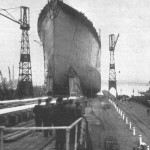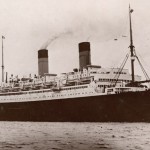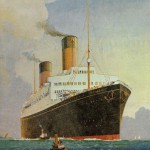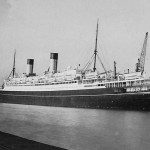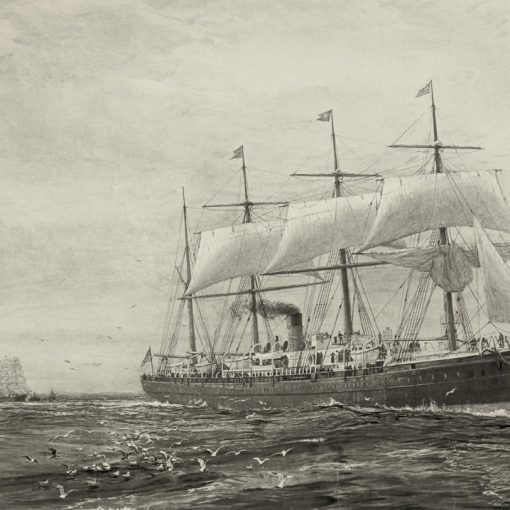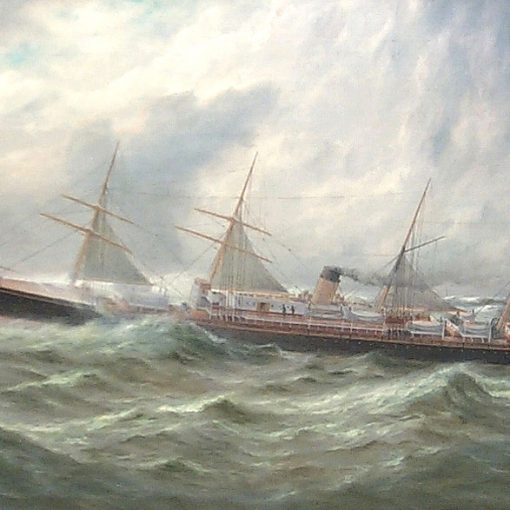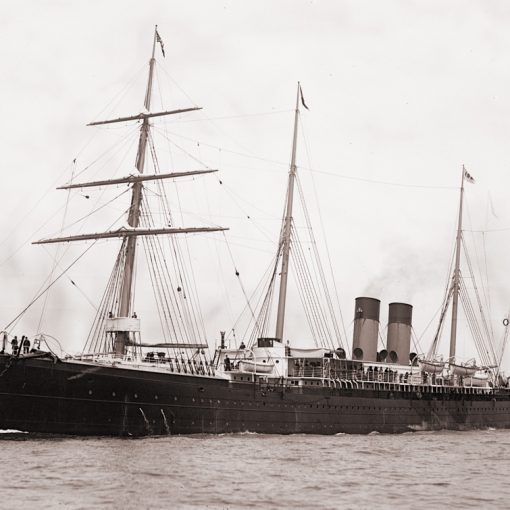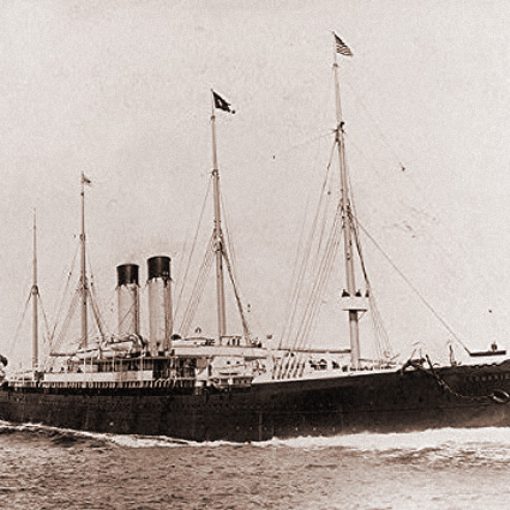1922 – 1936
Also known as Columbus
In the years prior to the First World War, Germany had to expand their merchant fleet because the large British liners was way ahead of Germany’s best bid. The Hamburg-Amerika Line was trusted to ensure Germany’s confidence with giants such as the Imperator-class vessels at over 50,000 tons. However, satisfaction was not reached with a single trio of large ships; some smaller vessels was also commissioned as a complement to what was supposed to be the finest merchant fleet in the world.
Two of these vessels were ordered by Norddeutscher Lloyd. The first of this class would be named Columbus and the second Hindenburg. At 35,000 tons they would be large ships, but their speed was not given much consideration. Because only two propellers powered such a large ship, the Columbus would only be able to maintain a service speed of 18 knots.
In December 1913, the Columbus was launched as the largest ship in Norddeutscher Lloyd’s possession. For a year work on the ship continued until the Great War broke out. In August 1914, all work was stopped, and the steamer was laid up in Danzig during the hostilities. From now on, the Columbus’ destiny follows the path of another great German ship: The 56,000-tonner Bismarck, third of the Imperator-class.
The war came and went; in 1918 it was all over. The following year, the Columbus along with many other German ships such as the Bismarck was ceded by the British as substitute for the ships they had lost in the war. The Bismarck was renamed Majestic and went into the hands of the White Star Line, replacing the mined Britannic. Also the Columbus was handed to White Star and renamed Homeric. Together with Majestic, the Columbus had mended the badly erased Olympic-class trio, and by the time she replaced the Titanic, the Columbus had been renamed Homeric.
The name ‘Homeric’ was certainly no coincidence. The White Star Line had planned to expand the Olympic-class trio into a quartet with a 50,000-ton Homeric. Originally the intended name for that vessel had been ‘Germanic’, but as irritation grew between Britain and Germany, ‘Homeric’ was chosen instead. In Germany, the Homeric’s former sister ship, the intended Hindenburg, was at a very early stage in construction, and did not awake any interest among the British. After having lost the ex-Columbus, the Germans renamed the Hindenburg Columbus, to psychologically overshadow the loss of the first ship.
In 1920, the Homeric was finished at last. She had been completed in Germany under the supervision by Harland and Wolff. By that period of time conversion into oil-burning was common, but still the Homeric was completed as a coal-burner. In early 1922, the Homeric arrived from Germany and received her actual renaming, and on February 15, that year, she steamed out on her maiden voyage after nearly ten years of waiting. Even though she was not very fast, it was noted that the ship was remarkably steady in rough seas. This made her very popular, and that seemed to make up for her slow appearance. However, the speed was somewhat bettered in October 1923, when the Homeric was taken in for her winter refit. The coal burning engines were removed and replaced by oil burning ones. On April 9, 1924, she was back in service, and the ship proved to be somewhat faster than before. Still, at 19.5 knots she could not be successfully matched with the Olympic and Majestic, both with a service speed above 23 knots. Nevertheless, the Homeric reduced one day on her average transatlantic voyage.
In the early 1920s, the Americans tried to halt the mass immigration to the country by restricting the number of allowed foreign settlers. Perhaps this was necessary, but it proved a massive stroke on the shipping lines. The Homeric was built with immigration in mind, and had large steerage areas. These became unused, and after a few years the White Star Line considered to put her on permanent cruise service because of the ship’s unprofitable transatlantic voyages.
However, the ex-German continued on her Atlantic service, but time showed that she had a hull from the early 1910s. In 1928, the thousand feet Oceanic was announced as a replacement, and on June 1, 1932 the Homeric made her final crossing over the Atlantic. The plans for permanent cruising were realised, and the Homeric was to cruise in the Mediterranean from British ports. She was one of the first ships ever to be used only as a cruise ship. She handled this position brilliantly, and soon the Homeric had worked up a superb cruising-reputation, partly because her steadiness. When at anchor, off Tenerife, on September 28, 1932, the vessel was damaged by the Cia Transmediterrania’s small Isla de Tenerife who had failed to steer whilst circling the Homeric. The larger ship was not badly damaged and her service was soon continued. In that winter, the Homeric cruised the West Indies in a sleepy mood. Unfortunately, cruising also became unprofitable, and with no passengers, she slowed down her tempo. The White Star Line had problems standing on its own in the hard times of the early thirties, so in 1934, the Homeric became part of the newly formed Cunard-White Star Line. The two old rivals had to merge in order to finish Cunard’s 80,000 ton Queen Mary. One of the last missions for the Homeric was to attend to King George V’s Silver Jubilee fleet review in July 1935. Only two months later, the Homeric was laid up. After that, she never saw any kind of service, for she was sold to Scottish ship breakers in 1936. She was evidently an old ship, but had only seen 13 years of actual service when she was retired.
Specifications
- 774 feet (236.4 m) long
- 82 feet (25 m) wide
- 34,351 gross tons
- Steam triple expansion engines powering two propellers
- 18.5 knot service speed
- Passenger capacity of 2,766 people

